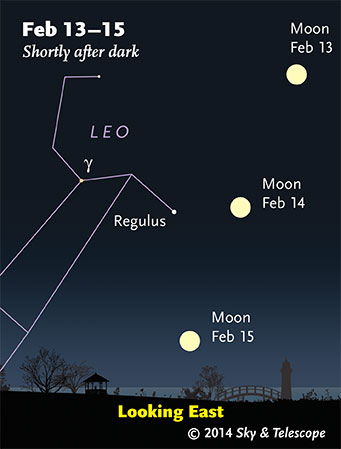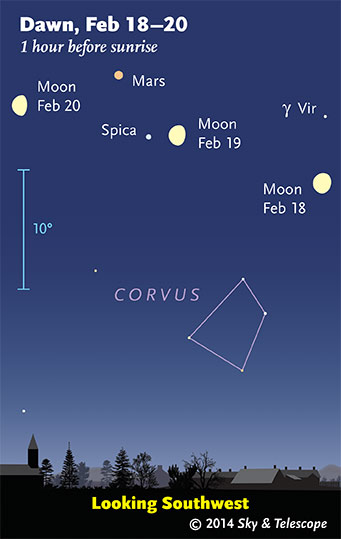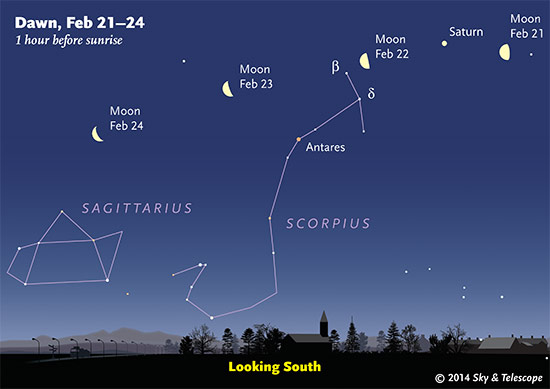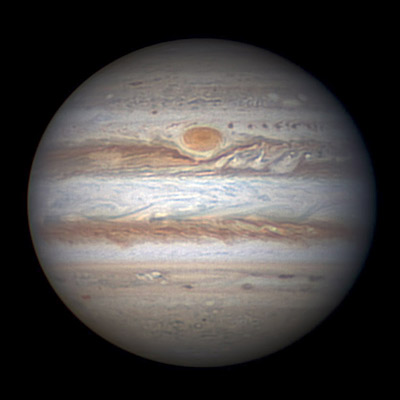Supernova 2014J, in the galaxy M82 off the Big Dipper, is fading but still within small-telescope range at 11th magnitude. The sky becomes dark and moonless in early evening starting on February 16th or 17th. See Supernova in M83 Passes Its Peak.

The full Moon pairs up with Regulus on Valentine's Day night. Such a pretty couple, if a bit mismatched.
Friday, February 14
Saturday, February 15
Sunday, February 16

Look southwest at dawn for the Moon in the southwest forming up with Mars and Spica.
Monday, February 17
And with a moderate to large telescope on a night of good seeing, this is when to try to detect the white-dwarf companion of Sirius, now 10.2 arcseconds east of the bright primary. See last October's Sky & Telescope, page 30, for tips and tricks when attempting this challeging project.
Tuesday, February 18
Wednesday, February 19

As the Moon wanes further, is passes Saturn and two "summer" constellations in early dawn.
Thursday, February 20
Friday, February 21
Saturday, February 22
Want to become a better astronomer? Learn your way around the constellations. They're the key to locating everything fainter and deeper to hunt with binoculars or a telescope.
This is an outdoor nature hobby. For an easy-to-use constellation guide covering the whole evening sky, use the big monthly map in the center of each issue of Sky & Telescope, the essential guide to astronomy. Or download our free Getting Started in Astronomy booklet (which only has bimonthly maps).

The Pocket Sky Atlas plots 30,796 stars to magnitude 7.6 — which may sound like a lot, but that's less than one star in an entire telescopic field of view, on average. By comparison, Sky Atlas 2000.0 plots 81,312 stars to magnitude 8.5, typically one or two stars per telescopic field. Both atlases include many hundreds of deep-sky targets — galaxies, star clusters, and nebulae — to hunt among the stars.
Sky & Telescope
Once you get a telescope, to put it to good use you'll need a detailed, large-scale sky atlas (set of charts). The standards are the little Pocket Sky Atlas, which shows stars to magnitude 7.6; the larger and deeper Sky Atlas 2000.0 (stars to magnitude 8.5); and once you know your way around, the even larger Uranometria 2000.0 (stars to magnitude 9.75). And read how to use sky charts with a telescope.
You'll also want a good deep-sky guidebook, such as Sue French's Deep-Sky Wonders collection (which includes its own charts), Sky Atlas 2000.0 Companion by Strong and Sinnott, the bigger Night Sky Observer's Guide by Kepple and Sanner, or the beloved if dated Burnham's Celestial Handbook.
Can a computerized telescope replace charts? Not for beginners, I don't think, and not on mounts and tripods that are less than top-quality mechanically (able to point with better than 0.2° repeatability, which means fairly heavy and expensive). As Terence Dickinson and Alan Dyer say in their invaluable Backyard Astronomer's Guide, "A full appreciation of the universe cannot come without developing the skills to find things in the sky and understanding how the sky works. This knowledge comes only by spending time under the stars with star maps in hand."
This Week's Planet Roundup

Jupiter on February 19th. South is up. The Great Red Spot is smack on the central meridian, at System II longitude 208°. Note the thin, very dark red edge of the Red Spot Hollow in which it sits, the massive white turbulence following (celestial east of) the spot in the South Equatorial Belt, the row of dark dots following the Red Spot in the very weak, thin South Temperate Belt, and the three white ovals at upper right in the South South Temperate Belt grouped like a Mickey Mouse hat. Jupiter never quits.
Mercury is hidden in the glare of the Sun.
Venus (magnitude –4.9, in Sagittarius) blazes whitely as the "Morning Star" before and during dawn; look southeast. It's at its brightest this week. A small telescope shows that it's a thickening crescent.
Mars (magnitude –0.3, in Virgo) rises around 10 p.m. now, a fiery blaze 5° or 6° to the right of icy Spica. The two of them are highest in the south around 3 or 4 a.m., with Spica now to Mars's lower right.
In a telescope Mars has grown to about 10.5 arcseconds wide, big enough for telescopes to show some features in good seeing. Mars will be 15.1″ wide when closest to Earth in mid-April.
Jupiter (magnitude –2.6, in Gemini) dominates the high southeast in early evening. It crosses nearly overhead (for skywatchers at mid-northern latitudes) around 8 or 9 p.m. Read lots about observing Jupiter telescopically in the January Sky & Telescope, or see our briefer online article Jupiter: Big, Bright, and Beautiful.
Saturn (magnitude +0.5, in Libra) rises around midnight or 1 a.m. and is highest in the south at the beginning of dawn. By then it's far to the left of Mars and Spica, and less far upper right of Antares.
Uranus sinks low in the west after dark.
Neptune is hidden behind the glare of the Sun.
All descriptions that relate to your horizon — including the words up, down, right, and left — are written for the world's mid-northern latitudes. Descriptions that also depend on longitude (mainly Moon positions) are for North America.
Eastern Standard Time (EST) is Universal Time (UT, UTC, or GMT) minus 5 hours.
Like This Week's Sky at a Glance? Watch our SkyWeek TV short, also playing on PBS.
To be sure to get the current Sky at a Glance, bookmark this URL:
http://SkyandTelescope.com/observing/ataglance?1=1
If pictures fail to load, refresh the page. If they still fail to load, change the 1 at the end of the URL to any other character and try again.
 0
0
Comments
You must be logged in to post a comment.